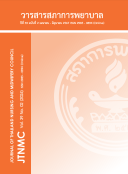Situations of Non-Communicable Diseases among Adults and Older Adults Living in Urban Community, Bangkok, Thailand
DOI:
https://doi.org/10.60099/jtnmc.v39i02.259284Keywords:
non-communicable diseases, adults and older adults, urban community, impacts, health practices, disease control and preventionAbstract
Introduction Non-communicable diseases (NCDs) are increasing as a health concern in urban Bangkok communities. The Princess Agrarajakumari College of Nursing at Chulabhorn Royal Academy is dedicated to serving communities experiencing diverse socio-economic challenges associated with NCDs. It is therefore crucial to study the situation of non-communicable diseases in the community in order to develop proactive care plans.
Objective To describe the situations of NCDs in the communities, including health problems, the impact of NCDs, and health practices to control and prevent the severity of NCDs in adults and older people living in communities of a district in the Bangkok metropolitan.
Design A descriptive study using the framework of non-communicable disease surveillance and control concepts of the World Health Organization, the Ministry of Public Health, and literature review.
Methodology The sample consisted of 1,360 adults and older adults with NCDs registered at a public health center in the study area of Bangkok. They were selected through simple random sampling from the list of adult and older people with NCDs registered from 68 communities, with 20 participants from each community who met the inclusion criteria. Data were collected using questionnaires on health problems, the impact of NCDs, and health practices to control and prevent the severity of NCDs. The questionnaires were developed by the researchers and assessed for content validity, revealing a content validity index of .90. The reliability of the questionnaire on the impact of NCDs was assessed using Cronbach’s alpha, resulting in a coefficient of .90, while the questionnaire on health practices to control and prevent the severity of NCDs yielded a Cronbach’s alpha coefficient of .91. Data were analyzed using descriptive statistics, including percentage, mean, standard deviation, median, minimum, and maximum values.
Results Most of the sample were female (62.50%), with ages ranging from 20 to 95 years, and a mean age of 57.80 years (SD = 14.6). The majority of the sample utilized universal health coverage (87.36%), while over half had a monthly income below 1,000 baht (56.47%) and were overweight (67.96%). The top three prevalent NCDs were hypertension (61.76%), dyslipidemia (46.18%), and diabetes (30.74%). Most of them had two or more chronic diseases, with complications such as heart disease, stroke, and chronic kidney disease. More than 40% of the sample experienced moderate to severe impacts on daily activity disturbance due to their conditions, including knee pain, back pain or shoulder pain, headache, insomnia, fatigue, distracted, irritable mood, anxiety, fear of burdening family, despair, bored, reduced daily activities, and decreased income. Additionally, there were challenges in health practices to control and prevent severity of NCDs including lack of exercise, poor dietary control, insufficient sleep, alcohol consumption, and smoking. Concerning medication adherence, nearly half of the sample (47.46%) did not regularly visit healthcare professionals but self-medicated, while 29.7% shared medications with neighbors experiencing similar symptoms.
Recommendations The findings of this study provide an initial recommendation for developing health behavioral modification programs for those with NCDs in the community focusing on dietary consumption, physical activity, and medication adherence. This includes improving health service systems to ensure continuous access to healthcare services for this population.
Downloads
References
Saha A, Alleyne G. Recognizing noncommunicable diseases as a global health security threat. Bull World Health Organ. 2018 Nov 1;96(11):792-3. https://doi.org/10.2471/blt.17.205732 PMID: 30455534
Niessen LW, Mohan D, Akuoku JK, Mirelman AJ, Ahmed S, Koehlmoos TP, Trujillo A, Khan J, Peters DH. Tackling socioeconomic inequalities and non-communicable diseases in low-income and middle-income countries under the Sustainable Development agenda. Lancet. 2018 May 19;391(10134):2036-2046. https://doi.org/10.1016/s0140-6736(18)30482-3 PMID: 29627160
NCD Countdown 2030 collaborators. NCD Countdown 2030: efficient pathways and strategic investments to accelerate progress towards the Sustainable Development Goal target 3.4 in low-income and middle-income countries. Lancet. 2022 Mar 26;399(10331):1266- 1278. https://doi.org/10.1016/s0140-6736(21)02347-3 PMID: 35339227
World Health Organization. Report of the first meeting of the Strategic and Technical Advisory Group for Noncommunicable Diseases: virtual meeting, 27–28 October 2021. Geneva: World Health Organization; 2021. Available from: https://iris.who.int/bitstream/handle/10665/352097/9789240041158-eng.pdf?sequence=1
United Nations Thematic Working Group on Noncommunicable Disease Prevention and Control: case study – Thailand. Geneva: World Health Organization and the United Nations Development Programme; 2021. Available from: https://iris.who.int/bitstream/handle/10665/349934/9789240037083-eng.pdf?sequence=1
Ministry of Public Health. Bureau of Non-Communicable Disease. The Policy and Strategy Section. 5-year national NCDs prevention and control strategic and action plan (2017-2021). Bangkok: Emotion Art; 2017.
Uddin R, Lee EY, Khan SR, Tremblay MS, Khan A. Clustering of lifestyle risk factors for non-communicable diseases in 304,779 adolescents from 89 countries: A global perspective. Prev Med. 2020 Feb;131:105955. https://doi.org/10.1016/j.ypmed.2019.105955 PMID: 31862205
Shakoori IS, Aslam F, Ashraf G, Akram H. Understanding chronic disease risk factors and multimorbidity. Int J Community Med Public Health. 2020 May;7(5): 1990-1993. https://doi.org/10.18203/2394-6040.ijcmph20201556
Adams AM, Islam R, Yusuf SS, Panasci A, Crowell N. Healthcare seeking for chronic illness among adult slum dwellers in Bangladesh: A descriptive cross-sectional study in two urban settings. PLoS ONE. 2020;15(6): e0233635. Available from: https://doi.org/10.1371/journal.pone.0233635
Kim S, Park M, Song R. Effects of self-management programs on behavioral modification among individuals with chronic disease: a systematic review and metaanalysis of randomized trials. PLoS ONE. 2021;16(7): e0254995. Available from: https://doi.org/10.1371/journal.pone.0254995
Campbell NRC, Paccot Burnens M, Whelton PK, Angell SY, Jaffe MG, Cohn J, et al. 2021 World Health Organization guideline on pharmacological treatment of hypertension: Policy implications for the region of the Americas. Lancet Reg Health Am. 2022;9:None. Available from: https://doi.org/10.1016/j.lana.2022.100219 PMID: 35711684
Sinthuchai S, Namdej N, Kittiboonthawal P, Dejpitaksirikul S, Chuencham J, Ubolwan K, et al. Health literacy development model to promote self-management behaviors and its health impact on older adults with both Type 2 diabetes and hypertension, in primary care clusters in Saraburi province. Journal of Thailand Nursing and Midwifery Council. 2022;37(1):58-74. Available from: https://he02.tci-thaijo.org/index.php/TJONC/article/view/253534/174198
Kumar A. The impact of obesity on cardiovascular disease risk factor. Asian J. Med. Sci. 2019;10(1): 1-12. https://doi.org/10.3126/ajms.v10i1.21294
Westgate CSJ, Israelsen IME, Jensen RH, Eftekhari S. Understanding the link between obesity and headachewith focus on migraine and idiopathic intracranial hypertension. J Headache Pain. 2021; 22(1):123. https://doi.org/10.1186/s10194-021-01337-0 PMID: 34629054
Mohammadi M, Ayoobi F, Khalili P, Soltani N, La Vecchia C, Vakilian A. Relation of hypertension with episodic primary headaches and chronic primary headaches in population of Rafsanjan cohort study. Sci Rep. 2021;11(1):24071. https://doi.org/10.1038/s41598-021-03377-7 PMID: 34911995
Lebel S, Mutsaers B, Tomei C, Leclair CS, Jones G, Petricone-Westwood D, et al. Health anxiety and illness-related fears across diverse chronic illnesses: A systematic review on conceptualization, measurement, prevalence, course, and correlates. PLoS One. 2020; 15(7):e0234124. https://doi.org/10.1371/journal.pone.0234124 PMID: 32716932
Estecha Querol S, Clarke P, Sattler ELP, Halford JCG, Gabbay M. Non-visible disease, the hidden disruptive experiences of chronic illness in adversity. Int J Qual Stud Health Well-being. 2020;15(1): 1857579. https://doi.org/10.1080/17482631.2020.1857579 PMID: 33287691
Brathwaite R, Hutchinson E, McKee M, Palafox B, Balabanova D. The long and winding road: a systematic literature review conceptualising pathways for hypertension care and control in low- and middleincome countries. Int J Health Policy Manag. 2022; 11(3):257-68. https://doi.org/10.34172/ijhpm.2020.105 PMID: 32702800
Downloads
Published
How to Cite
Issue
Section
License
Copyright (c) 2024 The Journal of Thailand Nursing and Midwifery Council

This work is licensed under a Creative Commons Attribution-NonCommercial-NoDerivatives 4.0 International License.







